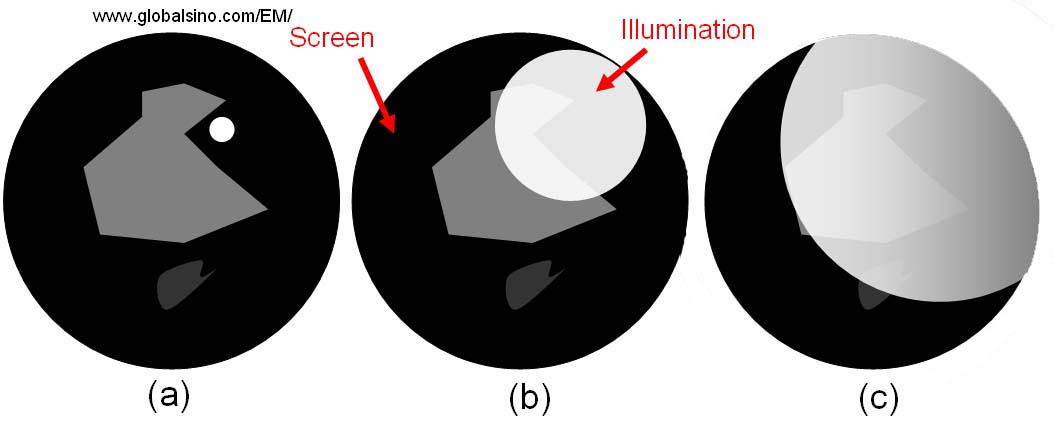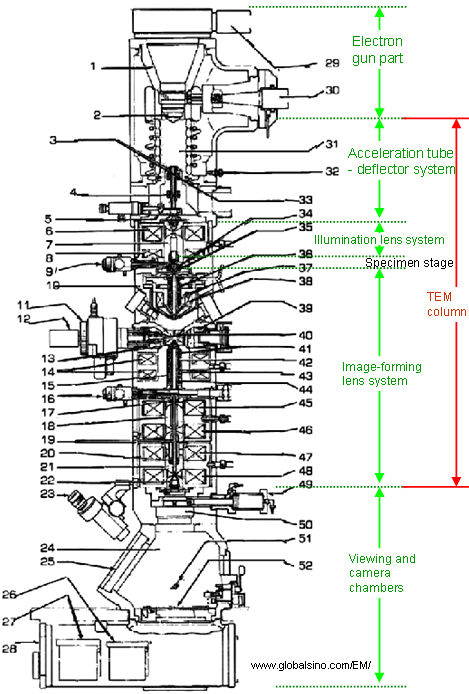=================================================================================
The schematic illustrations in Figure 4944a show the convergent illumination configurations of various modes in TEMs. In the CTEM condition in Figure 4944a (a), the condenser mini-lens (CM lens) is strongly excited, and incident electrons are focused on the pre-focal point of the objective pre-field, resulting in a parallel illumination on a wide area on the specimen and providing highly coherent electron illumination. In the EDS condition in Figure 4944a (b), the CM lens is turned off and the incident electrons are focused on the specimen by the objective pre-field, resulting in a small-probe illumination. In this case, the illumination angle (α1) is large so that high beam intensity is obtained for a small area in the analytical EDS method. In the NBD mode in Figure 4944a (c), a smaller condenser aperture is used to form a smaller illumination angle (α2). Therefore, a small-diameter probe with relatively high coherence in the illumination is achieved. In the illumination condition in Figure 4944a (c), the illumination angle (α) with a constant probe size can be changed by changing the excitations of the condenser lenses and the CM lens to obtain the incident illumination to form ideal convergent beam electron diffraction (CBED) patterns.
Figure 4944a. Convergent illumination configurations: (a) CTEM mode, (b) EDS mode and (c) NBD mode.
In conventional TEM systems, the TEM system is operated at TEM imaging mode and the TEM specimen is illuminated by an almost parallel electron
beam. The objective lens is used to form a magnified (intermediate) image of the
illuminated area before intermediate and projector lenses. This formed image is further magnified by postspecimen lenses onto the image
detector. More readings can be obtained at Difference of Imaging Geometries of TEM and STEM Systems.
In TEM operation, the electron beam at near crossover should be centered using the condenser X Y deflection coils (B1 and B2 double deflectors: see page1920) because an unevenly illuminated field of view will be induced when it is opened up if the beam is off center as shown in Figure 4944b.

Figure 4944b. Schematic illustration of uneven illumination if the beam at near crossover is not centered: (a) Beam crossover, (b) Beam is slightly opened, and (c) Beam is ‘widely’ opened.
The schematic illustration in Figure 4944c presents the position of illumination part in typical TEM systems.
 |
1. Electron gun
2. Wehnelt unit
3. Anode
4. Electron gun second beam delector coil
5. Anode chamber isolation valve
6. 1st condenser lens coil
7. Condenser polepiece
8. 3rd condenser lens coil
9. Condenser aperture assembly
10. Specimen chamber
11. Goniometer
12. specimen holder
13. Stigmator screening cylinder
14. Objective lens coil
15. Objective lens liner tube
16. Field limiting aperture
17. Intermediate lens stigmator
18. Intermediate polepiece
19. Intermediate lens linear tube
20. Projector lens beam deflector coil
21. Projector upper polepiece
22. Projector lower polepiece
23. Binoculars
24. Viewing chamber
25. Viewing window
26. Dispensing magazine
27. Receiving magazine
28. Camera chamber
29. Lift arm
30. HT cable to high voltage tank
31. Anode chamber, or called acceleration tube
32. Gas inlet
33. Electron gun 1st beam deflector coil
34. Condenser lens stigmator coil
35. Spot alignment coil
36. Condenser lens 1st beam deflector coil
37. Condenser lens 2nd beam deflector coil
38. Condenser minilens (CM) lens coil
39. Stage heater
40. Objective polepiece
41. Objective lens stigmator coil
42. 1st image shift coil
43. Objective minilens (OM) lens coil
44. 2nd image shift coil
45. 1st intermediate lens coil
46. 2nd intermediate lens coil
47. 3rd intermediate lens coil
48. Projector lens coil
49. Viewing chamber isolation valve
50. High resolution diffraction chamber
51. Small screen
52. Large screen |
Figure 4944c. Schematic illustration of the structure of typical TEM systems (e.g. JEM-2010F
here). |
Note that we need to recalibrate the condenser lens adjustment from the FilterControl software if the EEL specimen illumination changes when the spectrum offset is changed.
|

